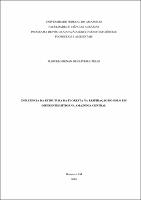| ???jsp.display-item.social.title??? |


|
Please use this identifier to cite or link to this item:
https://tede.ufam.edu.br/handle/tede/6822| ???metadata.dc.type???: | Dissertação |
| Title: | Influência da estrutura da floresta na respiração do solo em diferentes sítios na Amazônia Central |
| Other Titles: | Influence of forest structure on soil respiration in different sites in the Central Amazon |
| ???metadata.dc.creator???: | Teles, Marcelo Renan de Oliveira  |
| ???metadata.dc.contributor.advisor1???: | Azevedo, Celso Paulo de |
| First advisor-co: | Lima, Roberval Monteiro Bezerra de |
| ???metadata.dc.contributor.referee1???: | Lima, Roberval Monteiro Bezerra de |
| ???metadata.dc.contributor.referee2???: | Muniz, Aleksander Westphal |
| ???metadata.dc.contributor.referee3???: | Medeiros, Raquel da Silva |
| ???metadata.dc.description.resumo???: | O papel das florestas tropicais nas mudanças globais vem sendo estudado há vários anos e por vários pesquisadores do mundo, em função da sua dimensão e inter-relação com os gases de efeito estufa que influenciam no aquecimento do globo. O objetivo deste estudo é investigar a influência da estrutura da floresta na respiração do solo em diferentes sítios. Esta pesquisa foi realizada na Amazônia Central, na região metropolitana de Manaus, abrangendo 5 municípios, Manaus, Itacoatiara, Rio Preto da Eva, Iranduba e Manacapuru. As variáveis dependentes selecionadas para as análises foram o efluxo de CO2, CH4 e N2O, que apresentaram médias de 6,23 μmolCO2m-²s-¹; -4,86 μmolCH₄m-².h-¹ e 1,33 μmolN₂Om-²h-¹, respectivamente. Foram realizadas análises de correlação para avaliar as relações entre as variáveis das florestas, onde área basal, DAP máximo e índice de shannon apresentaram sinais de correlação com a respiração do solo; por sua vez as variáveis edafoclimáticas umidade do ar, umidade do solo e temperatura do ar também apresentaram correlações com os fluxos de CO2, CH4 e N2O. Análises de regressão foram realizadas para investigar a possibilidade de predição de fluxos de CO2, CH4 e N2O. Foram ajustados modelos de predição com as variáveis da estrutura da floresta como área Basal, dap médio e Índice de Shannon bem como a partir das variáveis edafoclimáticas. As médias dos parâmetros da estrutura floresta mostraram diferenças significativas entre os sítios estudados. O efluxo de gases de efeito estufa a partir do solo, nos sítios sob cobertura de florestas não apresentaram diferenças relacionadas ao CO2, entretanto apresentaram diferenças significativas entre alguns sítios para efluxos de CH4 e N2O. O presente estudo apresentou diferenças quando comparados efluxos de gases entre os sítios florestais e em sítios que ocorreram mudanças no uso da terra (pós-florestas). |
| Abstract: | The role of tropical forests in global change has been studied for several years and by various researchers in the world, due to its size and interrelation with the greenhouse gases that influence the global warming. The objective of this study is to investigate the influence of forest structure on soil respiration in different sites. This research was carried out in the central Amazonia, in the metropolitan region of Manaus, covering 5 municipalities, Manaus, Itacoatiara, Rio Preto da Eva, Iranduba and Manacapuru. The dependent variables selected for the analyzes were the efflux of CO2, CH4 and N2O, which presented a mean of 6.23 μmolCO2m-²s-¹; -4.86 μmolCH₄m-².h-¹ and 1.33 μmolN₂Om-²h-¹, respectively. Correlation analyzes were performed to evaluate the relationships between forest variables, where basal area, maximum DAP and shannon index showed signs of correlation with soil respiration; in turn the soil air humidity, soil moisture and air temperature variables also presented correlations with CO2, CH4 and N2O fluxes. Regression analyzes were performed to investigate the possibility of prediction of CO2, CH4 and N2O fluxes. Prediction models were adjusted with forest structure variables such as Basal area, mean dap and Shannon index as well as from the edaphoclimatic variables. The averages of the parameters of the forest structure showed significant differences between the studied sites. The efflux of greenhouse gases from the ground, in the sites under forest cover did not present differences related to CO2, however they presented significant differences among some sites for CH4 and N2O efflux. The present study presented differences when comparing gas outflows between forest sites and at sites that have changed land use (after-forests). |
| Keywords: | Efluxo de gases Carbon dioxide Dióxido de carbono Nitrous oxide Óxido nitroso Mudanças climáticas Floresta tropical |
| ???metadata.dc.subject.cnpq???: | CIÊNCIAS AGRARIAS: RECURSOS FLORESTAIS E ENGENHARIA FLORESTAL CIÊNCIAS AGRARIAS: RECURSOS FLORESTAIS E ENGENHARIA FLORESTAL: SILVICULTURA CIÊNCIAS AGRARIAS: RECURSOS FLORESTAIS E ENGENHARIA FLORESTAL: SILVICULTURA: SOLOS FLORESTAIS |
| Language: | por |
| ???metadata.dc.publisher.country???: | Brasil |
| Publisher: | Universidade Federal do Amazonas |
| ???metadata.dc.publisher.initials???: | UFAM |
| ???metadata.dc.publisher.department???: | Faculdade de Ciências Agrárias |
| ???metadata.dc.publisher.program???: | Programa de Pós-graduação em Ciências Florestais e Ambientais |
| Citation: | TELES, Marcelo Renan de Oliveira. Influência da estrutura da floresta na respiração do solo em diferentes sítios na Amazônia Central. 2018. 100 f. Dissertação (Mestrado em Ciências Florestais e Ambientais) - Universidade Federal do Amazonas, Manaus, 2018. |
| ???metadata.dc.rights???: | Acesso Aberto |
| URI: | https://tede.ufam.edu.br/handle/tede/6822 |
| Issue Date: | 31-Aug-2018 |
| Appears in Collections: | Mestrado em Ciências Florestais e Ambientais |
Files in This Item:
| File | Description | Size | Format | |
|---|---|---|---|---|
| Dissertação_Marcelo Teles_PPGCIFA | 4.61 MB | Adobe PDF |  Download/Open Preview |
Items in DSpace are protected by copyright, with all rights reserved, unless otherwise indicated.




